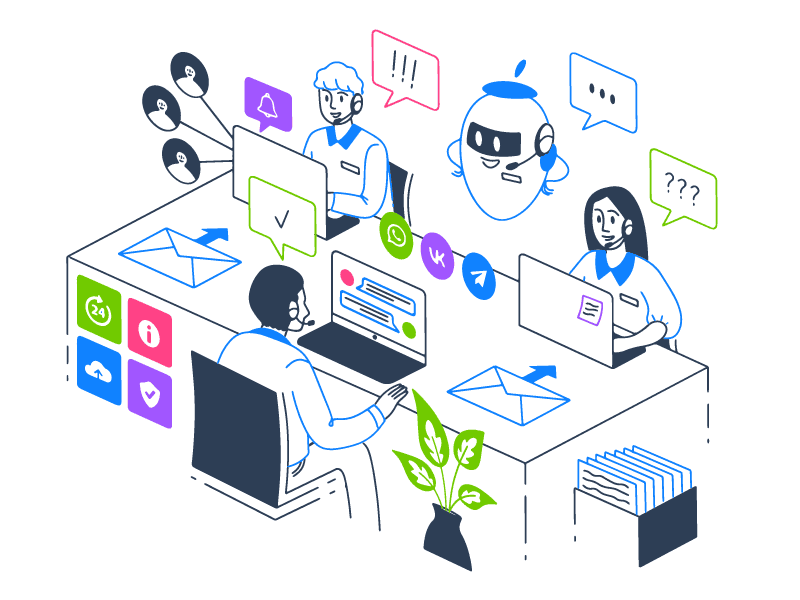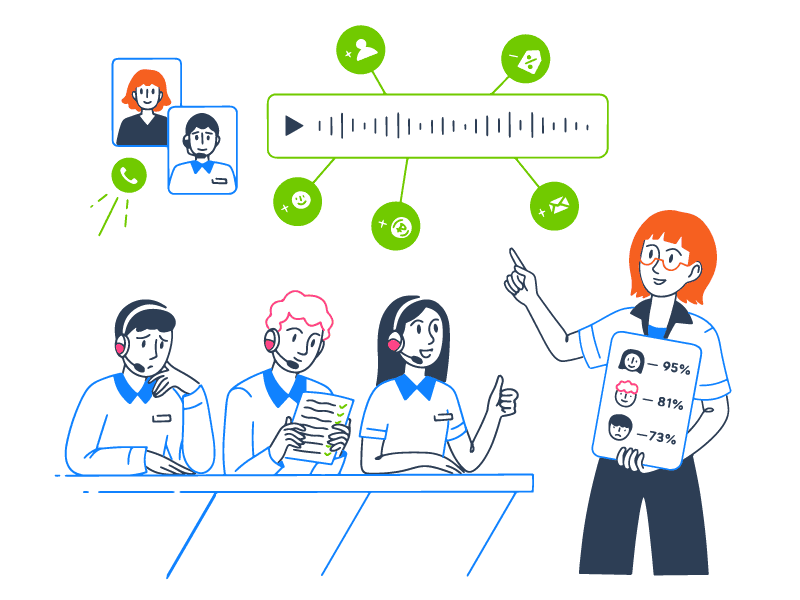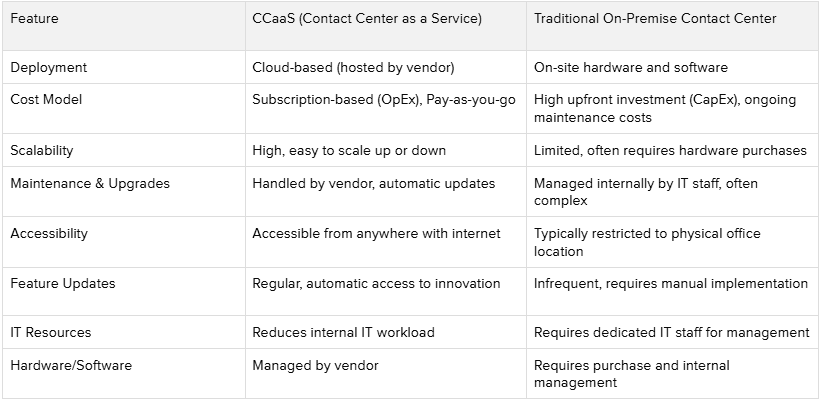
What is CCaaS (Contact center as a service)? A comprehensive guide
Introduction: Understanding CCaaS fundamentals
Contact Center as a Service, commonly known as CCaaS, represents a fundamental shift in how businesses manage customer interactions. It is a cloud-based software deployment model. Companies subscribe to access contact center software capabilities rather than building and maintaining infrastructure on-premise. This approach allows organizations to provide exceptional customer service across multiple channels, leveraging advanced technology without significant upfront investment.

The core idea behind service ccaas is flexibility and scalability. Businesses pay based on usage, typically a monthly or annual subscription per user or seat. This model empowers organizations of all sizes to access sophisticated tools. They can enhance the customer experience, optimize agent performance, and streamline operations within the organization. Understanding CCaaS is critical for any business looking to modernize its customer communication strategy today.
How does CCaaS work? The cloud advantage
At its heart, a CCaaS platform operates entirely in the cloud. This means the vendor manages all the underlying infrastructure, hardware and software updates, maintenance, and security. Businesses access the platform via the internet using secure logins. Agents can work from anywhere with an internet connection, supporting remote contact center operations.
The CCaaS vendor hosts the core software components. These often include Automatic Call Distribution (ACD), Interactive Voice Response (IVR), dialers, reporting tools, and integrations. The cloud-based nature ensures high availability and disaster recovery. It also allows for rapid deployment of new features and upgrades. This eliminates the lengthy procurement and installation cycles associated with traditional call center systems. The subscription model shifts costs from capital expenditure (CapEx) to operational expenditure (OpEx), offering predictable monthly expenses.
Important! The cloud architecture is fundamental to CCaaS. It enables the agility, scalability, and accessibility that differentiate it from legacy systems. Your organization benefits directly from the vendor's investment in infrastructure.
Data flow is managed securely between the customer, the agent, and the CCaaS platform. The system routes incoming customer interactions (calls, email, chat, social media) to the most appropriate agent based on predefined rules, skills, or AI-driven insights. This ensures efficient handling of inquiries and a consistent customer experience across all touchpoints.
Key features and capabilities of modern CCaaS platforms
Modern CCaaS solutions offer a rich set of features designed to optimize every aspect of customer communication and contact center operations. These capabilities go far beyond traditional call handling.
Omnichannel communication
True omnichannel support is a hallmark of advanced CCaaS platforms. Unlike multichannel (where channels exist but are siloed), omnichannel integrates all communication channels. This includes voice, email, web chat, SMS, social media, and messaging apps (like WhatsApp). It provides a seamless, consistent experience for both customers and agents. An agent can see the entire history of customer interactions across all touchpoints, providing context for personalized customer service. This unified view of customer data is crucial.
Advanced analytics and reporting
Data-driven insights are critical for optimizing performance. CCaaS solutions provide comprehensive analytics and unified reporting tools. These track key performance indicators (KPIs) and metrics in real-time and historically. Examples include average handle time (AHT), first call resolution (FCR), customer satisfaction (CSAT), and agent occupancy. Managers can monitor performance, identify trends, measure agent productivity, and make informed decisions to improve service quality. Natural language processing (NLP) may be used to analyze call transcripts or chat logs for sentiment and intent.
Artificial intelligence (AI) and automation
AI is increasingly integrated into CCaaS platforms. It powers features like intelligent routing (matching customers to the best agent based on intent, history, or personality), chatbots and virtual assistants for self-service, agent assist tools (providing real-time guidance), and predictive analytics. Automation handles repetitive tasks, freeing up agents for more complex inquiries. This technology helps personalize customer interactions at scale and improves operational efficiency. Sophisticated AI allows for natural language understanding.
Workforce engagement management (WEM)
Workforce Engagement Management (WEM) tools are often bundled or integrated with CCaaS solutions. WEM encompasses Workforce Management (WFM), Quality Management (QM), performance management, and agent coaching/training. WFM helps with forecasting call volume and scheduling staff effectively. QM allows supervisors to monitor interactions, score agent performance, and provide feedback. These tools are essential for managing agent workload, ensuring service quality, and keeping staff motivated, especially in a remote contact center environment.
CRM and system integration
Seamless integration with Customer Relationship Management (CRM) systems (like Salesforce, HubSpot, etc.) and other business tools is vital. This provides agents with a complete view of customer data directly within their interface. Integration enables personalized interactions based on purchase history, past support tickets, and customer preferences. CCaaS platforms often offer pre-built integrations or APIs for connecting systems with other critical business applications, creating a unified ecosystem.
Other integrations might include connections to unified communications platforms, knowledge bases, or specific industry software. The ability to connect systems with ease is a major advantage.
Security and compliance
Handling customer data requires robust security measures. Reputable CCaaS vendors invest heavily in security infrastructure and processes. They typically comply with industry standards like GDPR, HIPAA, PCI-DSS, and SOC 2. Features include encryption, access controls, audit logs, and secure data storage. Choosing a vendor with a strong security posture helps mitigate risk and ensures customer data privacy. This is especially important considering the potential impact on industry reputation.
The strategic advantages of choosing CCaaS

Adopting a CCaaS solution offers significant benefits for businesses aiming to improve customer service and operational efficiency. These advantages make it a compelling choice over traditional systems.
- Scalability and Flexibility: Easily scale services up or down based on demand (e.g., seasonal peaks). Add or remove agent seats quickly without hardware constraints. Supports remote and hybrid work models, allowing agents to work from anywhere.
- Cost Efficiency: Reduces upfront capital expenditure (CapEx) by eliminating the need to purchase and maintain hardware. Predictable subscription-based pricing (OpEx) simplifies budgeting. Reduces IT overhead associated with managing on-premise systems.
- Enhanced Customer Experience (CX): Provides seamless omnichannel support for consistent customer interactions. AI and data analytics enable personalized customer service. Faster response times and improved first contact resolution rates lead to higher satisfaction.
- Improved Agent Productivity: Unified agent desktops provide access to all tools and customer data in one place. AI-powered agent assist tools offer real-time support. WEM features help optimize scheduling and performance. Reduces agent frustration and turnover.
- Access to Innovation: Cloud-based model ensures automatic access to the latest features, upgrades, and technologies (like AI) deployed by the vendor. Businesses stay current without internal development efforts.
- Business Continuity and Reliability: Cloud infrastructure provides inherent redundancy and disaster recovery capabilities. High uptime SLAs ensure the contact center remains operational even during disruptions. Maintenance and upgrades are handled by the vendor with minimal downtime.
- Global Reach: Enables businesses to establish a global contact center presence easily, supporting multiple languages and regions without deploying local hardware.
These benefits collectively contribute to a more agile, efficient, and customer-centric contact center operation, helping businesses navigate the complexities of modern customer expectations.
CCaaS vs. traditional on-premise contact centers
Understanding the differences between CCaaS and traditional on-premise contact center solutions is key to making an informed decision. The contrast highlights the evolution of contact center technology.
Traditional systems require significant upfront investment in hardware (servers, phone systems) and software licenses. Ongoing costs include maintenance, upgrades, IT staff, and physical space. Scalability is often difficult and costly. New features require complex implementation projects. Agents are typically tied to a physical location.
CCaaS, on the other hand, operates on a subscription model with minimal upfront cost. The vendor handles infrastructure, maintenance, and upgrades. Scalability is inherent in the cloud model. New features are deployed automatically. It supports remote work seamlessly. This fundamental difference in deployment and cost model is critical.

While on-premise might offer perceived control for some organizations with very specific security or customization needs, the trend clearly favors the flexibility, cost-effectiveness, and innovation offered by CCaaS solutions for most businesses today.
CCaaS vs. UCaaS: Clarifying the difference
It's common to encounter both CCaaS and UCaaS (Unified Communications as a Service) when exploring cloud communication solutions. While related, they serve distinct primary purposes.
UCaaS focuses on internal collaboration and communication within the organization. It consolidates tools like business telephony (VoIP), video conferencing, instant messaging, presence information, and file sharing onto a single cloud platform. The main goal is to improve communication and collaboration between employees. Think platforms like Microsoft Teams (with phone system add-ons), Zoom Phone, or RingCentral MVP.
CCaaS, conversely, is primarily focused on managing external customer interactions across various channels. Its features are geared towards optimizing customer service, agent performance, and the overall customer experience. While it includes communication tools, they are specifically designed for contact center workflows (ACD, IVR, omnichannel routing, WEM, detailed customer interaction analytics).
However, the lines can blur. Many businesses benefit from integrating their CCaaS and UCaaS platforms. This integration allows seamless transfer of calls between contact center agents and back-office experts, shared presence information, and unified communications management. Some vendors offer both service ucaas and ccaas solutions, sometimes on a combined platform. The key distinction lies in the primary focus: internal collaboration (UCaaS) versus external customer interaction management (CCaaS).
Consider this: UCaaS facilitates interactions between employees, while CCaaS manages interactions between your business and both customers and prospects.
Choosing the right CCaaS provider: Key considerations
Selecting the right CCaaS vendor is a strategic decision. It impacts customer satisfaction, operational efficiency, and future growth. Careful planning and evaluation are essential.
Define your business needs
Before evaluating vendors, clearly define your requirements. Consider:
- What communication channels do your customers prefer? (Voice, email, chat, social media, etc.)
- What is your expected volume of customer interactions?
- How many agents do you need now, and how might that change?
- What are your key performance indicators (KPIs) for customer service?
- What specific features are critical? (e.g., specific integrations, AI capabilities, WEM)
- What are your security and compliance requirements?
- What is your budget? (Consider total cost of ownership, not just subscription fees).
Documenting these needs provides a clear benchmark for evaluating potential ccaas solutions.
Evaluate potential CCaaS vendors
Research different ccaas vendor options. Look beyond marketing materials. Consider factors like:
- Feature Set: Does the platform offer the specific capabilities you need? How intuitive is the interface?
- Industry Reputation: Check analyst reports (e.g., Gartner Magic Quadrant), customer reviews, and case studies. How long has the vendor been in the market?
- Reliability and SLAs: What uptime guarantees do they offer? What is their track record for reliability?
- Pricing Model: Understand the pricing structure (per agent, per usage, bundled features). Are there hidden costs?
- Support: What levels of technical support are offered? What are the response times? Is support available 24/7?
Shortlist vendors that align closely with your defined requirements. Consider providers like Genesys, NICE, Avaya, Talkdesk, Sprinklr, Five9, Cisco (Webex Contact Center), Amazon Connect, Zoom Contact Center, or even specialized players like Ozonetel depending on specific needs. Explore vendor websites, read newsroom updates, and look for investor relations information for company stability insights.
Consider scalability and future needs
Choose a platform that can grow with your business. Can it easily handle increased interaction volume or agent numbers? Does the vendor have a clear roadmap for future innovation? Ensure the selected ccaas solution can adapt to evolving customer expectations and technological advancements. Think about your long-term strategy.
Assess integration capabilities
Verify that the ccaas platform integrates smoothly with your existing systems, especially your CRM. Check for pre-built integrations and the availability of robust APIs for custom connections. Seamless integration is crucial for providing a unified view of customer data and streamlining workflows.
Review security, compliance, and support
Thoroughly review the vendor's security posture and compliance certifications (PCI, HIPAA, GDPR, etc.). Understand their data protection policies. Evaluate the quality and availability of their customer support and training resources. Ensure they can meet your organization's specific compliance and support needs.
Making the right ccaas selection requires careful consideration of these points to ensure the platform aligns with your current challenges and future goals.
Implementing a CCaaS solution: Steps for success
Migrating to a new CCaaS platform requires careful planning and execution. A structured approach minimizes disruption and maximizes the benefits.
- Planning and Strategy: Define clear goals, timelines, and roles. Identify key stakeholders. Develop a detailed migration plan, considering potential challenges. Align the implementation with overall business objectives.
- Data Migration: Plan how to migrate existing customer data, interaction history, and knowledge base content to the new platform. Ensure data integrity and security during the transfer.
- Configuration and Integration: Configure the CCaaS platform settings (routing rules, IVR scripts, queues). Set up necessary integrations with CRM and other business systems. Test connections thoroughly.
- Agent Training: Provide comprehensive training to agents and supervisors on using the new platform and its features. Focus on new workflows and capabilities. Ensure staff are comfortable before go-live.
- Testing: Conduct thorough end-to-end testing in a controlled environment. Simulate various interaction scenarios. Identify and resolve any issues or bugs.
- Go-Live: Execute the switch-over to the new CCaaS platform. Monitor the system closely during the initial period. Have support resources readily available.
- Monitoring and Optimization: Continuously monitor performance metrics and gather feedback from agents and customers. Identify areas for improvement and optimize configurations accordingly. Leverage analytics to refine strategies.
A well-managed implementation process is crucial for realizing the full potential of your chosen ccaas solution and ensuring a smooth transition for both employees and customers. Don't underestimate the importance of change management and communication throughout the process.
The future of customer interaction: Trends in CCaaS
The CCaaS market is constantly evolving, driven by technological advancements and changing customer expectations. Several key trends are shaping the future:
- Deeper AI Integration: AI will become even more pervasive, powering predictive engagement, hyper-personalization, sophisticated sentiment analysis, and more autonomous self-service options. Expect more advanced natural language processing capabilities.
- Proactive Engagement: Moving beyond reactive support, CCaaS platforms will increasingly enable proactive outreach based on customer behavior or predicted needs, further enhancing the customer relationship.
- Increased Emphasis on Agent Experience (AX): Vendors recognize that happy, empowered agents deliver better CX. Future developments will focus on tools that simplify agent workflows, reduce stress, and provide better coaching and support (advanced WEM).
- Tighter UCaaS/CCaaS Integration: The convergence of internal and external communication platforms will continue, providing a more unified experience across the organization.
- Composable CX: Businesses may move towards more modular solutions, selecting best-of-breed components via APIs rather than relying solely on a single vendor's monolithic platform, allowing for greater flexibility.
- Data Analytics Sophistication: Expect even more powerful, AI-driven analytics providing deeper insights into customer journeys and operational efficiency. Data-driven decision making will become standard.
Staying aware of these trends helps businesses prepare for the future and leverage new capabilities as they emerge. The goal remains to create seamless, personalized, and efficient customer communications.
Conclusion: Embracing the future of customer service
Contact Center as a Service (CCaaS) has fundamentally changed how businesses connect with their customers. By leveraging the power of the cloud, CCaaS solutions offer unparalleled flexibility, scalability, and access to advanced features like omnichannel support, AI, and sophisticated analytics. It empowers businesses to deliver exceptional customer experiences, optimize agent performance, and operate more efficiently, often reducing the total cost of ownership compared to traditional systems.
Whether you are migrating from an aging on-premise system or starting fresh, understanding the capabilities, benefits, and considerations of CCaaS is essential. Choosing the right ccaas platform and implementing it strategically allows your organization to meet today's demanding customer expectations and adapt to the future of customer communication. It's no longer just about handling calls; it's about managing the entire customer journey across all touchpoints, driven by data and powered by flexible technology. Adopting CCaaS is a critical step for any business serious about customer service excellence.
Frequently asked questions (FAQ)
What is the main difference between CCaaS and a traditional call center?
The main difference lies in the deployment model and infrastructure management. CCaaS is cloud-based, offered as a subscription service where the vendor manages the infrastructure, software updates, and maintenance. Traditional call centers use on-premise hardware and software that the business must purchase, install, manage, and maintain internally. This results in differences in cost structure (OpEx vs. CapEx), scalability, flexibility, and access to new features.
Is CCaaS secure?
Yes, reputable CCaaS vendors invest heavily in security. They typically adhere to stringent international and industry-specific compliance standards (like GDPR, HIPAA, PCI-DSS, SOC 2). Security measures include data encryption, secure network architecture, access controls, regular audits, and disaster recovery protocols. However, it's crucial to vet a vendor's specific security certifications and practices during the selection process.
Can small businesses use CCaaS?
Absolutely. One of the major advantages of CCaaS is its scalability and flexible pricing models (often per-user, per-month). This makes sophisticated contact center technology accessible and affordable for small and medium-sized businesses (SMBs) that couldn't justify the high upfront costs of traditional on-premise systems. SMBs can start small and scale as they grow.
What is omnichannel CCaaS?
Omnichannel CCaaS refers to platforms that integrate multiple communication channels (voice, email, chat, SMS, social media, video, etc.) into a single, unified system. It allows customers to switch channels seamlessly during an interaction, and provides agents with a complete view of the customer's history across all touchpoints. This contrasts with multichannel, where channels exist but operate in silos.
How does CCaaS improve customer experience (CX)?
CCaaS improves CX in several ways: by providing seamless omnichannel support, reducing wait times through intelligent routing, enabling personalization using integrated customer data and AI, offering self-service options via IVR or chatbots, and ensuring consistent service quality through analytics and agent performance tools. Faster resolution and personalized interactions lead to higher customer satisfaction.

